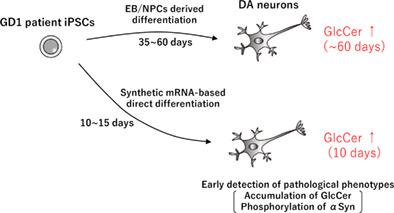当前位置:
X-MOL 学术
›
Stem Cells Transl. Med.
›
论文详情
Our official English website, www.x-mol.net, welcomes your feedback! (Note: you will need to create a separate account there.)
Synthetic mRNA‐based differentiation method enables early detection of Parkinson's phenotypes in neurons derived from Gaucher disease‐induced pluripotent stem cells
STEM CELLS Translational Medicine ( IF 6 ) Pub Date : 2020-12-20 , DOI: 10.1002/sctm.20-0302 Tomohiko Akiyama 1 , Saeko Sato 1 , Shigeru B H Ko 1 , Osamu Sano 2 , Sho Sato 3 , Masayo Saito 2 , Hiroaki Nagai 2 , Minoru S H Ko 1 , Hidehisa Iwata 2
STEM CELLS Translational Medicine ( IF 6 ) Pub Date : 2020-12-20 , DOI: 10.1002/sctm.20-0302 Tomohiko Akiyama 1 , Saeko Sato 1 , Shigeru B H Ko 1 , Osamu Sano 2 , Sho Sato 3 , Masayo Saito 2 , Hiroaki Nagai 2 , Minoru S H Ko 1 , Hidehisa Iwata 2
Affiliation

|
Gaucher disease, the most prevalent metabolic storage disorder, is caused by mutations in the glucocerebrosidase gene GBA1, which lead to the accumulation of glucosylceramide (GlcCer) in affected cells. Gaucher disease type 1 (GD1), although defined as a nonneuronopathic subtype, is accompanied by an increased risk of Parkinson's disease. To gain insights into the association of progressive accumulation of GlcCer and the Parkinson's disease phenotypes, we generated dopaminergic (DA) neurons from induced pluripotent stem cells (iPSCs) derived from a GD1 patient and a healthy donor control, and measured GlcCer accumulation by liquid chromatography‐mass spectrometry. We tested two DA neuron differentiation methods: a well‐established method that mimics a step‐wise developmental process from iPSCs to neural progenitor cells, and to DA neurons; and a synthetic mRNA‐based method that overexpresses a transcription factor in iPSCs. GD1‐specific accumulation of GlcCer was detected after 60 days of differentiation by the former method, whereas it was detected after only 10 days by the latter method. With this synthetic mRNA‐based rapid differentiation method, we found that the metabolic defect in GD1 patient cells can be rescued by the overexpression of wild‐type GBA1 or the treatment with an inhibitor for GlcCer synthesis. Furthermore, we detected the increased phosphorylation of α‐synuclein, a biomarker for Parkinson's disease, in DA neurons derived from a GD1 patient, which was significantly decreased by the overexpression of wild‐type GBA1. These results suggest that synthetic mRNA‐based method accelerates the analyses of the pathological mechanisms of Parkinson's disease in GD1 patients and possibly facilitates drug discovery processes.
中文翻译:

基于合成 mRNA 的分化方法能够早期检测源自戈谢病诱导的多能干细胞的神经元中的帕金森表型
戈谢病是最常见的代谢性贮积症,由葡萄糖脑苷脂酶基因GBA1突变引起,这会导致葡萄糖神经酰胺 (GlcCer) 在受影响的细胞中积累。戈谢病 1 型 (GD1) 虽然被定义为非神经元病亚型,但伴随着帕金森病的风险增加。为了深入了解 GlcCer 的进行性积累和帕金森病表型的关联,我们从 GD1 患者和健康供体对照的诱导多能干细胞 (iPSC) 中生成多巴胺能 (DA) 神经元,并通过液相色谱测量 GlcCer 积累-质谱。我们测试了两种 DA 神经元分化方法:一种成熟的方法,它模拟从 iPSC 到神经祖细胞和 DA 神经元的逐步发育过程;以及一种在 iPSC 中过表达转录因子的基于 mRNA 的合成方法。前一种方法在分化 60 天后检测到 GlcCer 的 GD1 特异性积累,而后一种方法仅在 10 天后检测到。通过这种基于合成 mRNA 的快速分化方法,我们发现 GD1 患者细胞中的代谢缺陷可以通过野生型 GBA1 的过表达或用 GlcCer 合成抑制剂治疗来挽救。此外,我们检测到来自 GD1 患者的 DA 神经元中 α-突触核蛋白(帕金森病的生物标志物)的磷酸化增加,而野生型 GBA1 的过表达显着降低了这种磷酸化。这些结果表明,基于合成 mRNA 的方法加速了对 GD1 患者帕金森病病理机制的分析,并可能促进药物发现过程。
更新日期:2020-12-20
中文翻译:

基于合成 mRNA 的分化方法能够早期检测源自戈谢病诱导的多能干细胞的神经元中的帕金森表型
戈谢病是最常见的代谢性贮积症,由葡萄糖脑苷脂酶基因GBA1突变引起,这会导致葡萄糖神经酰胺 (GlcCer) 在受影响的细胞中积累。戈谢病 1 型 (GD1) 虽然被定义为非神经元病亚型,但伴随着帕金森病的风险增加。为了深入了解 GlcCer 的进行性积累和帕金森病表型的关联,我们从 GD1 患者和健康供体对照的诱导多能干细胞 (iPSC) 中生成多巴胺能 (DA) 神经元,并通过液相色谱测量 GlcCer 积累-质谱。我们测试了两种 DA 神经元分化方法:一种成熟的方法,它模拟从 iPSC 到神经祖细胞和 DA 神经元的逐步发育过程;以及一种在 iPSC 中过表达转录因子的基于 mRNA 的合成方法。前一种方法在分化 60 天后检测到 GlcCer 的 GD1 特异性积累,而后一种方法仅在 10 天后检测到。通过这种基于合成 mRNA 的快速分化方法,我们发现 GD1 患者细胞中的代谢缺陷可以通过野生型 GBA1 的过表达或用 GlcCer 合成抑制剂治疗来挽救。此外,我们检测到来自 GD1 患者的 DA 神经元中 α-突触核蛋白(帕金森病的生物标志物)的磷酸化增加,而野生型 GBA1 的过表达显着降低了这种磷酸化。这些结果表明,基于合成 mRNA 的方法加速了对 GD1 患者帕金森病病理机制的分析,并可能促进药物发现过程。



























 京公网安备 11010802027423号
京公网安备 11010802027423号